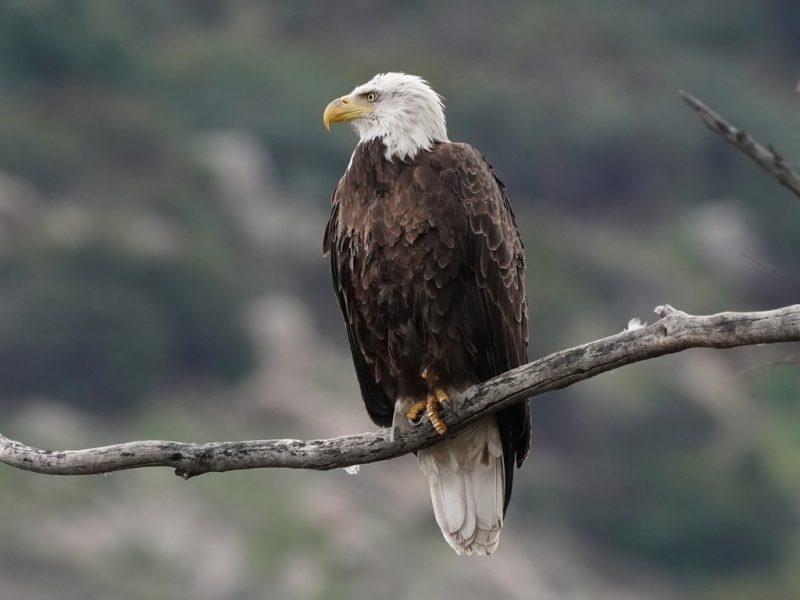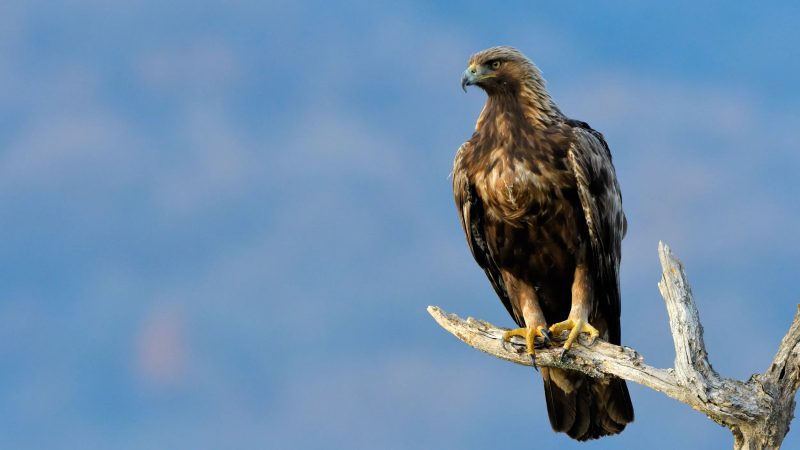Eagles in Iowa are a magnificent sight for bird watchers and nature lovers alike. The state hosts several impressive eagle species that showcase powerful flight and striking appearances. Learning about these eagles helps deepen appreciation for Iowa’s rich wildlife.
Among the most notable Eagles in Iowa is the Bald Eagle, famous for its white head and broad wingspan. Alongside it, the Golden Eagle occasionally visits during migration, bringing a rare glimpse of its golden-feathered beauty. Even rarer are sightings of the White-tailed Eagle, a large Eurasian species that sometimes appears as a vagrant.
This guide introduces 3 types of Eagles in Iowa with clear identification tips and photos. Bird watchers can discover where and when to spot these majestic birds across Iowa’s diverse landscapes.
Common Eagles Found in Iowa
Bald Eagle (Haliaeetus leucocephalus)

The Bald Eagle is the most iconic and widely recognized eagle species in Iowa and across the United States. It is easily identified by its striking white head and tail, which contrast sharply with its dark brown body and wings. Its bright yellow eyes and large hooked yellow beak add to its distinctive appearance. Bald Eagles develop their full adult plumage, including the white head and tail, around 4 to 5 years of age.
In terms of size, Bald Eagles are among the largest raptors in North America. They typically measure between 28 to 40 inches (70 to 102 cm) in length, with a wingspan ranging from 6 to 7.5 feet (1.8 to 2.3 meters). They usually weigh between 6.6 and 14 pounds (3 to 6.3 kg). Their broad wings allow them to soar effortlessly while searching for food or scouting their territory.
Behaviorally, Bald Eagles are skilled hunters and scavengers. Their primary diet consists of fish, which they catch by swooping down and snatching from the water with their sharp talons. They also eat birds, small mammals, and carrion when available. Bald Eagles are known for their powerful flight and territorial nature, especially during breeding season. In winter, many Bald Eagles gather near unfrozen lakes and rivers to fish.
In Iowa, Bald Eagles are most commonly found near large bodies of water such as the Mississippi River and reservoirs like Saylorville Lake and Red Rock Lake. Thanks to successful conservation programs and habitat protection, Bald Eagle populations in Iowa have grown steadily over the past decades, making them a symbol of wildlife recovery in the state.
Golden Eagle (Aquila chrysaetos)

The Golden Eagle is one of North America’s largest and most powerful raptors. It is easily identified by its dark brown feathers with a striking golden sheen on the back of its neck and head, which gives it its name. Unlike the Bald Eagle, the Golden Eagle lacks the white head and tail, having more uniformly brown plumage. Its strong yellow beak and legs are built for hunting and gripping prey.
Golden Eagles have a body length ranging from 26 to 40 inches (66 to 102 cm) and a wingspan of about 6 to 7.2 feet (1.8 to 2.2 meters). They weigh between 6.6 and 15 pounds (3 to 6.8 kg), making them similar in size to Bald Eagles but with a more slender build. Their long broad wings and powerful muscles allow for fast and agile flight, especially when hunting.
In terms of behavior, Golden Eagles are highly skilled hunters that primarily prey on small to medium-sized mammals such as rabbits, squirrels, and groundhogs. They are known for their incredible speed and can dive at prey from great heights. Golden Eagles prefer open landscapes such as grasslands and foothills, but in Iowa, they are mostly seen during migration or rare visits.
Golden Eagles are not common residents in Iowa but are occasionally spotted passing through during migration seasons in fall and spring. They are more often found in western parts of the U.S., but these majestic birds sometimes travel eastward, making sightings in Iowa exciting for bird watchers.
White-tailed Eagle (Haliaeetus albicilla)

The White-tailed Eagle, native to Eurasia, is a large eagle species that closely resembles the Bald Eagle but is slightly bigger and has some distinct differences. It has a broad wingspan, a pale grayish body with a whitish tail, and a large yellow beak. Its head is more robust and less sharply white compared to the Bald Eagle’s, and the tail is wedge-shaped rather than fan-shaped.
This eagle can reach lengths of 28 to 39 inches (71 to 98 cm) and a wingspan up to 8 feet (2.45 meters), making it one of the largest eagles in the world. It weighs between 7.7 and 16 pounds (3.5 to 7.5 kg). Its powerful build and broad wings enable soaring for hours while scanning for prey or carrion.
White-tailed Eagles are apex predators in their native ranges and feed on fish, water birds, and small mammals. They often scavenge carrion and are known for their impressive hunting skills and strong territorial behavior. They prefer coastal cliffs, large lakes, and river habitats.
Although White-tailed Eagles are not native to North America, there have been very rare and accidental sightings in places like Iowa, usually due to vagrant individuals crossing from Europe or being escapees from captivity. These sightings are extremely rare and considered remarkable among local birders.
Best Times and Places to See Eagles in Iowa
The best time to observe eagles in Iowa largely depends on the species and their seasonal behavior. For Bald Eagles, winter months from December through February offer prime viewing opportunities. During this time, many Bald Eagles congregate near large rivers and reservoirs where the water remains unfrozen, providing abundant fishing spots. Key locations include the Mississippi River along Iowa’s eastern border, especially near Lock and Dam areas such as Lock and Dam 13 at Clinton and Lock and Dam 14 near Le Claire. These areas attract large numbers of Bald Eagles feeding on fish and waterfowl.
Spring and fall migration periods are ideal for spotting Golden Eagles, which pass through Iowa while traveling between their northern breeding grounds and southern wintering areas. Golden Eagles are more likely to be seen soaring over open landscapes, prairies, and agricultural fields in western Iowa during these migration windows. Sightings are less frequent than Bald Eagles but highly rewarding for eagle enthusiasts.
For the rare White-tailed Eagle, sightings are unpredictable and extremely uncommon in Iowa. However, bird watchers should remain alert near large water bodies and open landscapes during winter and migration seasons, as these are the habitats where vagrant individuals might appear.
Overall, visiting major water bodies, state parks, and wildlife refuges during the colder months, especially along the Mississippi River corridor, offers the best chance to witness the majesty of Eagles in Iowa. Early mornings and late afternoons are often the most active times for eagle hunting and soaring behavior.
Frequently Asked Questions About Eagles in Iowa
What species of eagles can be found in Iowa?
The most common eagle species in Iowa is the Bald Eagle. Golden Eagles are occasionally seen during migration, and the White-tailed Eagle is a very rare visitor.
When is the best time to see Bald Eagles in Iowa?
The best time to see Bald Eagles is during the winter months, from December to February, when they gather near unfrozen rivers and lakes to hunt for fish.
Where are the best places to spot eagles in Iowa?
Top locations include the Mississippi River corridor, especially near Lock and Dam sites such as Lock and Dam 13 at Clinton and Lock and Dam 14 near Le Claire, as well as large reservoirs like Saylorville Lake and Red Rock Lake.
Are Golden Eagles common in Iowa?
Golden Eagles are not common residents in Iowa. They are mostly seen during spring and fall migrations, especially in open western parts of the state.
Can I see White-tailed Eagles in Iowa?
White-tailed Eagles are native to Eurasia and are not native to Iowa. Sightings are extremely rare and usually involve vagrant or escaped birds.
What do eagles in Iowa eat?
Eagles primarily feed on fish, but they also eat waterfowl, small mammals, and carrion. Bald Eagles are especially known for fishing near rivers and lakes.
How large are eagles found in Iowa?
Bald Eagles and Golden Eagles typically have wingspans between 6 to 7.5 feet (1.8 to 2.3 meters) and weigh between 6 to 15 pounds (3 to 7 kg).
Are eagles protected in Iowa?
Yes, Bald Eagles and other eagles are protected under federal laws such as the Bald and Golden Eagle Protection Act, making it illegal to harm or disturb them or their nests.






